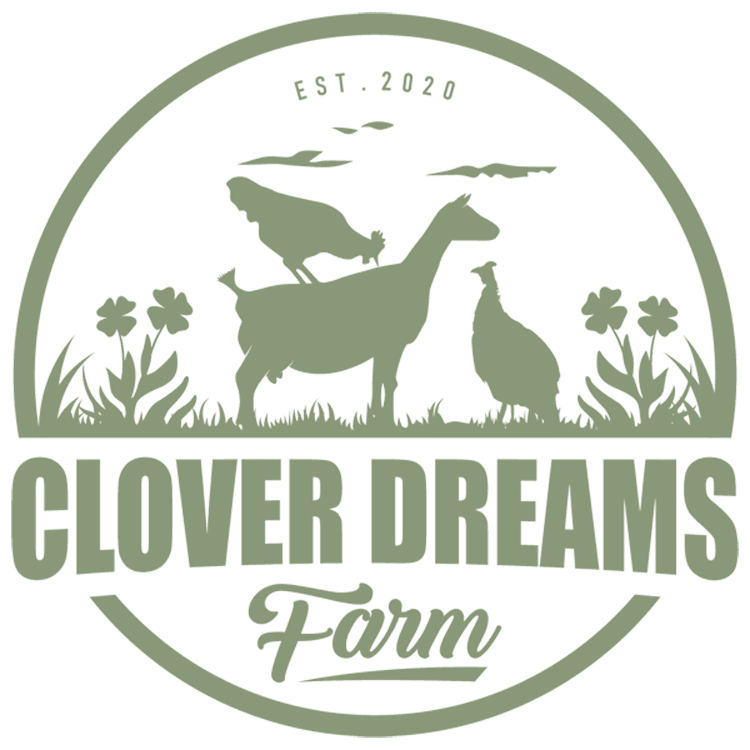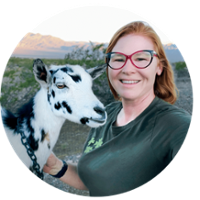So, you’re bringing home goats—welcome to the adventure! Whether you’re adding them to a homestead, planning for fresh milk, or simply looking for fun-loving backyard pets, one thing’s for sure: happy, healthy goats make life better.
At Clover Dreams Farm, we’ve built our herd with care, and along the way, we’ve learned a thing or two (or a hundred). This guide covers everything you need to get started, from basic care to feeding tips—so you can feel confident knowing you’re giving your goats the best.
Disclaimer: We’re passionate about goats and love sharing what we’ve learned through hands-on experience at Clover Dreams Farm. However, we are not veterinarians. This guide is based on our insights and practices, but every goat and situation is unique. If you have concerns about your goat’s health or care, we always recommend consulting a trusted veterinarian or experienced goat mentor.
First up: the essentials—because a well-prepared goat owner is a happy one. 🐐🍀
🐐 Goat Essentials Checklist
✅ Companionship is Key – Goats are herd animals and need a buddy of their own kind. A lonely goat is a sad (and noisy) goat!
✅ Fresh Water – Goats can be picky about their water—keep it clean and cool. We use 2-gallon buckets for kids and short stock tanks or 5-gallon buckets for adults.
✅ Shelter – A dry, wind-free space is a must. We use Pet Barns (dog houses) and IBC totes (Goat Condos). Bonus: A Pet Barn roof doubles as a sunny nap spot!
✅ Bedding – Inside shelters, we use pelletized bedding in summer to soak up urine. In winter, a thick layer of straw keeps goats warm and cozy. We don’t provide bedding in the entire pen—we find that it makes stall clean up day easier with a leaf blower.
✅ Fencing – We use 16-foot cattle or goat panels from TSC. These allow goats to stand on the fence without breaking it. Avoid welded wire; the welds will break over time.
Minimum height: 50 inches
Keep climbing structures away from fences to prevent escape attempts!
✅ Collars – We use plastic chain collars with poly chain links (Jeffers). These break under stress, keeping your goat safe.
✅ Travel – For Nigerian Dwarfs, we love 36” plastic dog kennels—safe, spacious, and easy to clean. They work for both kids and adults, keeping travel stress low (and mess contained!)
🥕 Safe Treats & Foods to Avoid
Safe Treats (in moderation!):
✔ Carrots, pumpkin, squash
✔ Black oil sunflower seeds
✔ Watermelon
✔ Animal crackers
Toxic & Avoid:
🚫 Oleander, lantana, azaleas, rhubarb, wilted cherry leaves
🚫 Bread, dog/cat food, avocados, potatoes
🚫 Excessive grain (can cause bloat)
👉 Helpful resource: Fiasco Farm’s Poisonous Plant List
🩺 Signs of a Healthy Goat (and When to Worry)
Healthy Goat Checklist:
✅ Bright, alert, and social
✅ Eats and chews cud regularly
✅ Smooth coat, clear eyes, and pink gums
✅ Pellet poop (not runny or clumpy)
Warning Signs:
⚠ Loss of appetite, bloating, excessive teeth grinding
⚠ Runny poop, lethargy, hunched posture
⚠ Labored breathing, weakness, odd behavior
🚨 If your goat shows these signs, consult a vet or experienced goat keeper ASAP!
🩹 First Aid & Goat Care Kit
Always good to have on hand:
🟢 Flexible Thermometer (Normal temp: 101.5-103.5°F)
🟢 Goat Nutri-Drench (For quick energy & immune support)
🟢 Electrolytes (For dehydration)
🟢 VetRx (For respiratory support & congestion relief)
🦶 Health & Hoof Care
CD&T Vaccine
All our goats receive the CD&T vaccine, which helps protect against Clostridium perfringens types C & D and Tetanus. Some goats may develop a small lump near the front leg—this is a normal reaction and should resolve on its own.
💉 We recommend an annual CD&T booster to maintain protection. If you're unsure about timing, check with your veterinarian or local goat mentor for guidance on scheduling.
Hoof Trimming
Trim hooves every 2–3 months to prevent overgrowth and discomfort. We recommend Producer’s Pride Burgon & Ball Footrot Shears (TSC).
🌿 Minerals & Nutrition
Recommended Pre-Mixed Minerals:
Manna Pro (Orange Bag, TSC) – Great for all goats; contains ammonium chloride to help prevent urinary issues.
Purina/Dumor Goat Minerals – Best for goats not eating alfalfa.
Sweetlix Meat Maker – Great for non-alfalfa diets; contains cobalt.
Sweetlix Magnum Milk – For goats eating alfalfa or Chaffhaye.
NEW (Feb 2025): We’ve transitioned to a Free Choice Mineral System—allowing goats to select minerals individually.
🚛 Quarantine & Introducing New Goats
When bringing a new goat home, quarantine for at least 2 weeks away from the herd. Stress from moving weakens the immune system, and this time allows them to adjust, build resilience, and prevent illness from spreading.
Tips for a smooth transition:
Keep them in a quiet space with consistent food, water, and routine.
Monitor closely for changes in appetite, droppings, or energy levels.
Gradual introductions to the herd work best! Start with a fence buffer before full integration.
🐐 Goat Kid Care
Feeding:
Our Nigerian Dwarf kids get free-choice orchard alfalfa hay, plus:
Chaffhaye refreshed twice daily
Kent Blue Seal Home Fresh 16 Grow and Finish 18DQ Goat Feed (Shipped to us by Tractor Supply)
💡 We recommend keeping this diet until 6 months old for the smoothest transition.
At 6 months of age, we recommend:
Doelings: Stay on Chaffhaye or transition to an alfalfa mix.
Wethers: Switch to Bermuda hay—low in protein & calcium, reducing urinary risks.
Grow & Finish Pellet can be stopped at this stage for non-breeding goats.
Health Notes:
✔ All kids are disbudded at Clover Dreams Farm. Bud caps may fall off—this is normal! Hair will grow over the spots.
✔ Castration (Wethers) – Testicles are banded and will atrophy/fall off in a few weeks.
Bonding:
Be calm and patient. Sit with them, let them approach on their own time—treats help!
🐐 Does in Milk: Daily Milking Routine & Feeding
Goats are social animals that thrive on routine and predictability. A consistent schedule helps them feel secure and reduces stress.
Milking Routine:
🕕 Milk twice daily (6 AM & 6 PM)
🫙 Sanitize & strip before using the Simple Pulse Milking Machine, then hand-milk the last bit.
🧴 Post-milking teat spray: Fight Bac or Chlorhexidine for udder health.
🔼 Milking stand setup: Goats walk up a ramp and eat concentrate while milking.
Milking Doe Diet:
✔ Free-choice orchard alfalfa hay
✔ Chaffhaye (20% of body weight daily, split into two feedings)
✔ Concentrate mix: Elk Grove Milling Pelleted Goat Feed Mix
🎉 Welcome to the wonderful world of goats! If you have any questions, reach out—we love helping fellow goat enthusiasts! 🐐💕


